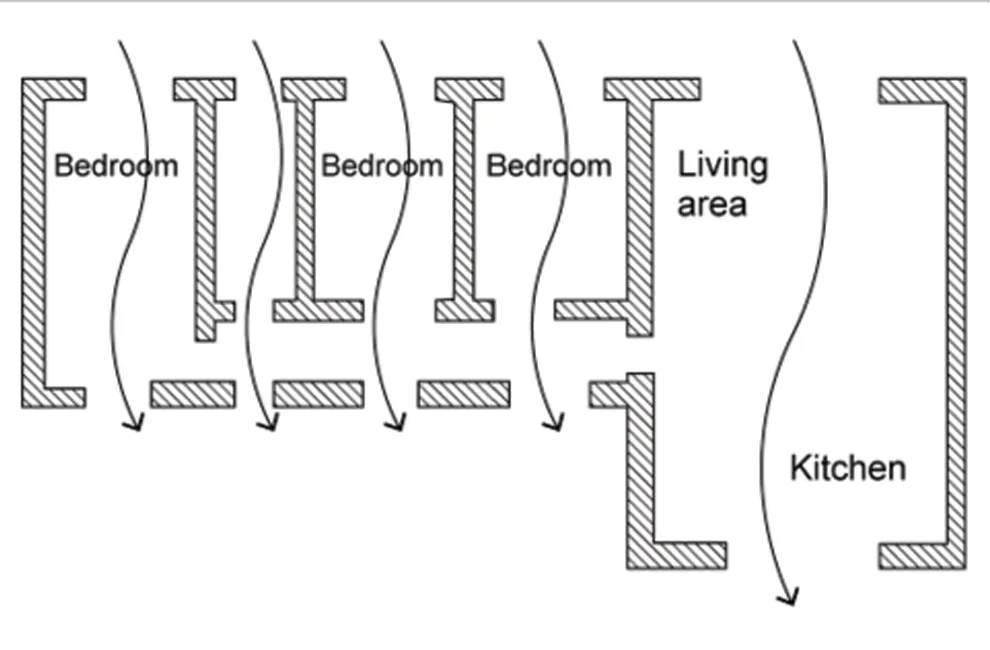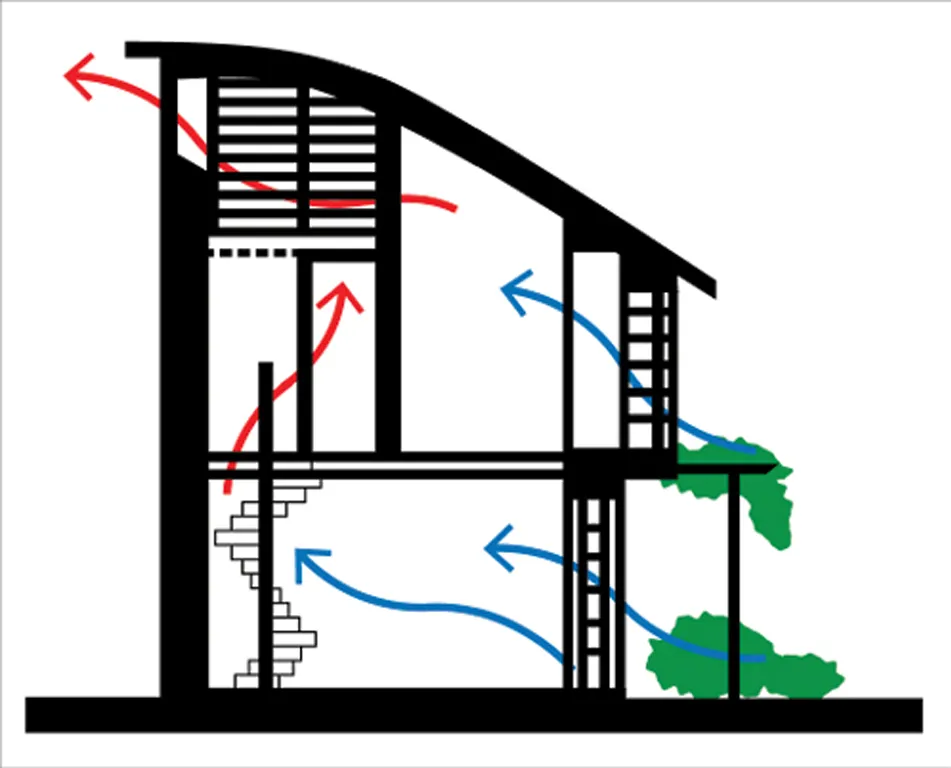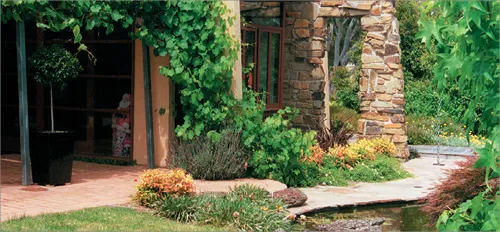If you want to know about the climate specific design principles or introduction of passive design or sustainable site planning, please click the link.
Passive cooling is a type of cooling technology that does not require the use of external power or energy sources to function. Instead, it utilizes natural or inherent physical properties, such as convection, radiation, or thermal mass, to dissipate or transfer heat from a building, device, or system to the surrounding environment.
- To be comfortable, buildings in all climates require some form of cooling at some time of the year. There are many ways you can design or modify your home to achieve comfort through passive (non-mechanical) cooling, as well as hybrid approaches which utilise mechanical cooling systems.
- The most appropriate passive cooling strategies for your home — including orientation, ventilation, windows, shading, insulation and thermal mass — are determined by climate, so first identify your climate zone by reading Design for climate.
- The balance between summer cooling and winter heating should be adjusted for climate through appropriate passive design.

- Verandas, underfloor ventilation and shady plantings keep this Darwin classic comfortable in the heat.
1) What is passive cooling?
- Passive cooling is the least expensive means of cooling a home in both financial and environmental terms.
- As cooling requirements are dictated by climate, distinctly different approaches to passive cooling are required for:
- hot humid climates where no heating is required
- temperate and warm climates where both heating and cooling are required
- cool and cold climates where heating needs are more important.
Cooling people
- Factors affecting comfort for people (human thermal comfort) are outlined in Design for climate and include both physiological and psychological factors.
- To be effective, passive cooling needs to cool both the building and the people in it.
- Evaporation of perspiration is the most effective physiological cooling process. It requires air movement and moderate to low humidity (less than 60%).
- Radiant heat loss is also important, both physiologically and psychologically. It involves direct radiation to cooler surfaces.
- Conduction contributes to both types of comfort and involves body contact with cooler surfaces. It is most effective when people are sedentary (e.g. sleeping on a water bed).
Cooling buildings
- The efficiency of the building envelope can be maximised in a number of ways to minimise heat gain:
- shading windows, walls and roofs from direct solar radiation
- using lighter coloured roofs to reflect heat
- using insulation and buffer zones to minimise conducted and radiated heat gains
- making selective or limited use of thermal mass to avoid storing daytime heat gains.
- To maximise heat loss, use the following natural sources of cooling:
- air movement
- cooling breezes
- evaporation
- earth coupling
- reflection of radiation.
Cooling sources
- Sources of passive cooling are more varied and complex than passive heating, which comes from a single, predictable source — solar radiation.
- Varying combinations of innovative envelope design, air movement, evaporative cooling, earth-coupled thermal mass, lifestyle choices and acclimatisation are required to provide adequate cooling comfort in most climate zones.
- Additional mechanical cooling may be required in hot humid climates and in extreme conditions in many climates, especially as climate change leads to higher temperatures during the daytime and overnight.
2) Air movement
- Air movement is the most important element of passive cooling. It cools people by increasing evaporation and requires both breeze capture and fans for back-up in still conditions.
- It also cools buildings by carrying heat out of the building as warmed air and replacing it with cooler external air.
- Moving air also carries heat to mechanical cooling systems where it is removed by heat pumps and recirculated.
- This requires well-designed openings (windows, doors and vents) and unrestricted breeze paths.
- In all climates, air movement is useful for cooling people, but it may be less effective during periods of high humidity.
- Air movement exposes the skin to dryer air.
- Increased air speeds do not increase cooling at lower relative humidity but air speeds up to 1.0m/s can increase evaporative cooling in higher humidity.
Air speeds above 1.0m/s usually cause discomfort.
Cool breezes
- Where the climate provides cooling breezes, maximising their flow through a home when cooling is required is an essential component of passive design.
- Unlike cool night air, these breezes tend to occur in the late afternoon or early evening when cooling requirements usually peak.

- Cool breezes work best in narrow or open plan layouts and rely on air-pressure differentials caused by wind or breezes.
- They are less effective in:
- buildings with deep floor plans or individual small rooms
- long periods of high external temperature (ambient or conducted heat gains above 35–40 watts per square metre (W/m2)
- locations with high noise, security risk or poor external air quality, where windows may need to be closed.
- Coastal breezes are usually from an onshore direction.
- In mountainous or hilly areas, cool breezes often flow down slopes and valleys in late evening and early morning, as heat radiating to clear night skies cools the land mass and creates cool air currents.
- Thermal currents are common in flatter, inland areas, created by daily heating and cooling. They are often of short duration in early morning and evening but with good design can yield worthwhile cooling benefits.
Cool night air
- Cool night air is a reliable source of cooling in inland areas where cool breezes are limited and diurnal temperature ranges usually exceed 6−8°C.
- Hot air radiating from a building fabric’s thermal mass is replaced with cooler night air drawn by internal−external temperature differentials rather than breezes.
- Full height, double hung windows are ideal for this purpose.
- Further cooling can be gained by including whole of house fans (see below).
Convective air movement
- The rule of convection: warm air rises and cool air falls.
- Stack ventilation, or convective air movement, relies on the increased buoyancy of warm air which rises to escape the building through high level outlets, drawing in lower level cool night air or cooler daytime air from shaded external areas (south) or evaporative cooling ponds and fountains.

- Convection causes warm air to rise, drawing in cool air.
- Convective air movement improves cross-ventilation and overcomes many of the limitations of unreliable cooling breezes. Even when there is no breeze, convection allows heat to leave a building via clerestory windows, roof ventilators and vented ridges, eaves, gables and ceilings.
- Convection produces air movement capable of cooling a building but usually has insufficient air speed to cool people.
Solar chimneys
- Solar chimneys enhance stack ventilation by providing additional height and well-designed air passages that increase the air pressure differential.
- Warmed by solar radiation, chimneys heat the rising air and increase the difference in temperature between incoming and out-flowing air.
- The increase in natural convection from these measures enhances the draw of air through the building.

- Solar chimneys enhance ventilation.
3) Evaporative cooling
- As water evaporates it draws large amounts of heat from surrounding air.
- Evaporation is therefore an effective passive cooling method, although it works best when relative humidity is lower (70% or less during hottest periods) as the air has a greater capacity to take up water vapour.
- Rates of evaporation are increased by air movement.
- Pools, ponds and water features immediately outside windows or in courtyards can pre-cool air entering the house.
- Carefully located water features can create convective breezes.
- The surface area of water exposed to moving air is also important.
- Fountains, mist sprays and waterfalls can increase evaporation rates.

Ponds pre-cool air before it enters a house.
- Mechanical evaporative coolers are common in drier climates and inland areas where relative humidity is low.
- They use less energy than refrigerated air conditioners and work better with doors and windows left open.
- Their water consumption can be considerable.
4) Earth coupling
- Earth coupling of thermal mass protected from external temperature extremes (e.g. floor slabs) can substantially lower temperatures by absorbing heat as it enters the building or as it is generated by household activities.

- Earth coupling utilises cooler ground temperatures.
- Passively shaded areas around earth-coupled slabs keep surface ground temperatures lower during the day and allow night-time cooling.
- Poorly shaded surrounds can lead to earth temperatures exceeding internal comfort levels in many areas. In this event, an earth-coupled slab can become an energy liability.
- Earth-coupled construction (including slab-on-ground and earth covered or bermed) utilises stable ground temperatures at lower depths to absorb household heat gains.
However, passive cooling has limitations, particularly in areas with high ambient temperatures and humidity, where it may not provide sufficient cooling or thermal comfort. It is also dependent on local climate conditions and may require careful planning and design to optimize its effectiveness.